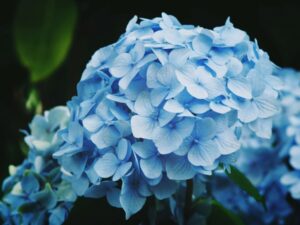Heather N. Kolich, ANR Agent, UGA Extension Forsyth County
I’ve always considered hydrangeas a staple of southern landscapes, so I was delighted to discover one in the backyard last spring after Beloved Husband cleared a jungle of invasive, non-native privet. Free from the suffocating privet, the small bigleaf hydrangea (Hydrangea macrophylla) pushed out a few lovely, blue blooms. I pruned it a bit after blooming, and this year it has doubled in size and flowers.

The blue flower indicates that the soil is acidic, as is normal for Georgia soils in the piedmont region. One of the magical things about big leaf hydrangea is that this same plant would bloom pink if soil pH were alkaline.
Hydrangeas are garden treasures throughout the U.S., Europe, and Asia. They grow in hardiness zones 3-10; present as climbing vines, small shrubs, large shrubs, and small trees; can be deciduous or evergreen; and offer a variety of bloom shapes.

The bloom is a compound inflorescence made up of many flowers that keep coming throughout summer. Plant hydrangeas where they have afternoon shade, well-drained soil, and make sure they have plenty of water, and they will thrive for many years. Annual pruning ensures good blooming for the next summer, but the timing of pruning depends on the species of hydrangea.
Identifying hydrangea species
The most common types of hydrangeas we see in landscapes are smooth (H. arborescens), oakleaf (H. quercifolia), panicle (H. paniculata), and bigleaf (H. macrophylla).
Smooth hydrangea. Native to the eastern U.S., H. arborescens are cold-hardy, deciduous small shrubs. Smooth hydrangeas produce a big “pompom” bloom that is naturally white, but plant breeders have developed several cultivars with pink flowers. It grows 3-5 feet tall and wide with a rounded form. Leaves are simple and ovate with serrate margins and turn golden yellow in the fall. Smooth hydrangea blooms on new, spring-growth wood, so prune H. arborescens in late winter. Pruning smooth hydrangea to 6-12 inches above the ground stimulates vigorous regrowth.

Oakleaf hydrangea. This large shrub gets its name from the shape of its leaves and grows quickly to 6-8 feet tall and wide. Native to the southeastern U.S., it does best in full to partial shade in Georgia. It has a loose, irregular form, and roots easily where branches touch ground with plenty of organic matter. Flowers are white on long panicles, but as the sepals that overlap flower edges mature, they turn rosy pink. Leaves turn deep red in the fall. Oakleaf hydrangeas flower on old wood, so prune H. quercifolia immediately after flowers fade. Prune lightly, removing spent blooms and leaving plenty of stem length to enjoy the exfoliating bark throughout the winter.

Panicle hydrangea. Multi-stemmed and growing up to 25 feet tall, H. paniculata is native to eastern and southern Asia. Also known as peegee and tree hydrangea, it’s more tolerant of sun than other species are. Cone-shaped blooms start white then change to green, pink, or red as summer wanes. Deciduous leaves turn gold in fall. Panicle hydrangeas bloom on new spring growth, so prune H. paniculata in late winter before spring growth begins. Prune lightly to remove old flowers and dead branches and to improve plant form, but resist cutting it back hard. Allow panicle hydrangeas to grow tall and express their various arching, cascading, or erect habits.
Bigleaf hydrangea. This beloved, ancient plant is the image that “hydrangea” conjures for many people. Native to Japan, there are now over 500 cultivars of H. macrophylla. Typical plants grow 3-6 feet high and wide as rounded mounds, but some reach 10 feet. Traditional bigleaf hydrangeas bloom on old wood, so prune H. macrophylla immediately after flowers fade. Some newer H. macrophylla cultivars are “reblooming” types that bloom on new, vegetative spring growth as well as on last year’s wood. These remontant hydrangeas were trademarked “Endless Summer” and brought to market in 2004. Reblooming hydrangeas can be pruned immediately after blooms fade, but if a hard freeze kills the buds, they can be pruned in late winter and will still bloom.